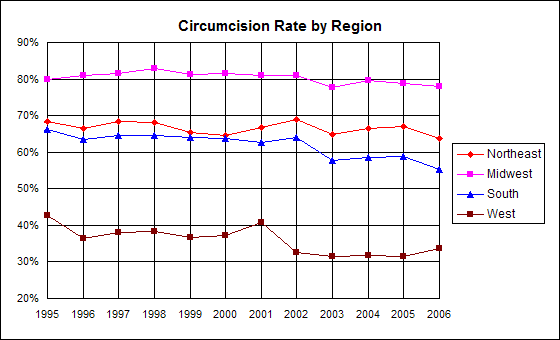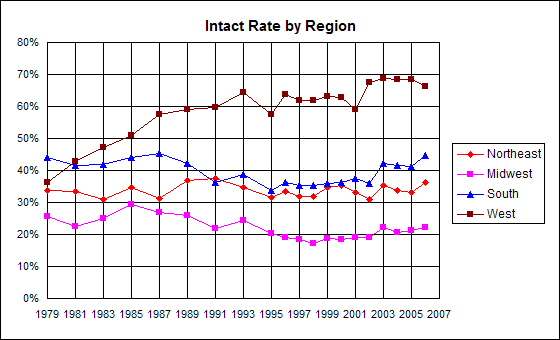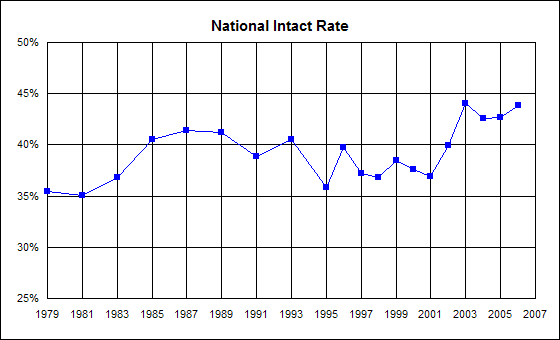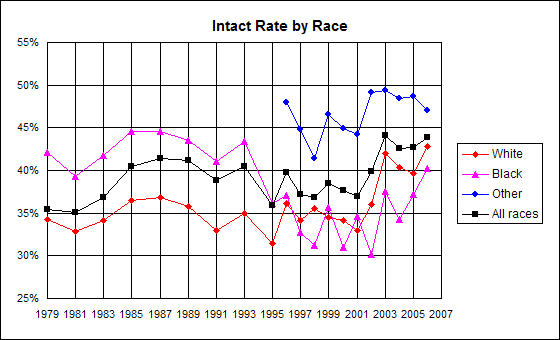The United States Centers for Disease Control and Prevention (CDC) released new statistics at the International AIDS 2010 conference in Vienna, Austria, that were obtained from SDI Health, a commercial source of medical statistics. The new statistics showed a
steep drop in the number of circumcisions performed in the United States. The new data were presented by Charbel E. El Becheraoui, a CDC researcher.
The CDC data, reported by the New York Times, showed that the incidence of circumcision declined from 56 percent in 2006 to 32.5 percent in 2009. According to these statistics, non-circumcision or genital integrity has become the normal condition among newborn boys in the United States.
One may view a map that shows the incidence of circumcision for each state individually. Move the cursor over the state to read the most recent available statistics for that state.
In 1971, the American Academy of Pediatrics (AAP) reported that there are no valid medical indications for circumcision in the neonatal period.3 After that the nationwide incidence of neonatal circumcision continued the slow decline that started in 1965, although Wallerstein (1985) reported spot samples of 77 to 98 percent.4
In 1989, the AAP issued a statement that claimed that circumcision had potential benefits
.5 The publication of this statement temporarily arrested the decline in circumcision. Nelson et al., who used a different source, the National Inpatient Survey (NIS), reported an increase in the incidence of circumcision in the 1988-2000 period.6 Based on the NIS, Nelson et al. reported a circumcision incidence of 48.3 percent in 1988-91, but the NHSD reported an incidence of 58.8 percent in 1989, 59.0 percent in 1990, and 61.1 percent in 1991. There would have been little or no increase if Nelson et al. had used data from the NHDS.
In 1999, the AAP issued yet another statement that said the data on potential benefits were insufficient to recommend the practice of neonatal non-therapeutic circumcision.7 Shortly thereafter, the American Medical Association declared that neonatal circumcision is a non-therapeutic procedure.8 More parents began to opt for genital integrity and the percentage of boys circumcised once again began to decline.
Recent statistical data. Data regarding newborn circumcision are available both from the National Hospital Discharge Survey and the National Inpatient Survey.
The National Hospital Discharge Survey (NHDS) which samples about 5 percent of hospital discharges. The NHDS produces data by four census regions8 and nationwide figure. There are about 2,000,000 boys born alive in the United States each year, so each percentage point change in the national rate equates to approximately 20,000 boys. Raw data are stored in the
10 Data Warehouse.
The nationwide circumcision rate had been fluctuating in the low 60 percent range for some years, but a decline in the percentage of boys circumcised started in 2002 and continued into 2003. From 2002 to 2003 declines occured in all four census regions. Non-circumcision has been the norm in the Western Region for more than a decade. The Southern Region now is approaching parity. The circumcision rate gained slightly in 2004.10
This information varies from that provided by the National Center for Health Statistics (NCHS) because the NCHS uses data only for blacks and whites. Also, the NCHS pages have not been updated since 1999. Other population groups are excluded from their calculations. The data provided here includes all population groups.
The National Hospital Discharge Survey (NHDS) is produced by the National Center for Health Statistics (NCHS), which is an agency of the Centers for Disease Control. The NCHS is located at Hyattsville, MD 20782.
| Year | 1994 | 1995 | 1996 | 1997 | 1998 | 1999 | 2000 | 2001 | 2002 | 2003 | 2004 | 2005 | 2006 |
| Northeast Region | 69.6% | 68.3% | 66.5% | 68.3% | 68.0% | 65.4% | 64.6% | 66.9% | 68.9% | 64.7% | 66.4% | 66.9% | 63.6% |
| North Central Region | 80.1% | 79.8% | 80.9% | 81.6% | 82.9% | 81.4% | 81.4% | 81.0% | 81.0% | 77.8% | 9.5% | 78.7% | 77.9% |
| Southern Region | 64.7% | 66.1% | 63.6% | 64.5% | 64.6% | 64.1% | 63.9% | 62.5% | 64.0% | 57.7% | 58.5% | 58.7% | 55.3% |
| Western Region | 34.2% | 42.6% | 36.3% | 38.0% | 38.3% | 36.7% | 37.3% | 40.9% | 32.6% | 31.4% | 31.7% | 31.5% | 33.8% |
| All Regions | 62.7% | 64.1% | 60.2% | 62.8% | 63.2% | 61.5% | 62.4% | 63.1% | 60.1% | 55.9% | 57.4% | 57.3% | 56.1% |

The decline of 7.2 percentage points from 2001 to 2003 represents approximately 144,000 boys annually who were not circumcised.
The genital integrity rates (percentage of boys leaving the hospital intact) are presented below. Circumcision hit its highest level in 1965, at which point the genital integrity rate was just 15 percent.1 It has rebounded sharply since then.
The intact rate increased in all four census regions of the United States from 2002 to 2003 and the nationwide incidence of boys with intact genitals was 44.1 percent in 2003, based on data from the NHDS. The North Central Region rebounded to above 20 percent, and the Southern Region increased to above 40 percent. The intact rate slipped back a bit between 2003 and 2004.
| Year | 1994 | 1995 | 1996 | 1997 | 1998 | 1999 | 2000 | 2001 | 2002 | 2003 | 2004 | 2005 | 2006 |
| Northeast Region | 30.4% | 31.7% | 33.5% | 31.7% | 32.0% | 34.6% | 35.4% | 33.1% | 31.1% | 35.3% | 33.6% | 33.1% | 36.4% |
| North Central Region | 19.9% | 20.2% | 19.1% | 18.4% | 17.1% | 18.6% | 18.6% | 19.0% | 19.0% | 22.2% | 20.5% | 21.3% | 22.1% |
| Southern Region | 35.3% | 33.9% | 36.4% | 35.5% | 35.4% | 35.9% | 36.1% | 37.5% | 36.0% | 42.3% | 41.5% | 41.3% | 44.7% |
| Western Region | 65.8% | 57.4% | 63.7% | 62.0% | 61.7% | 63.3% | 62.7% | 59.1% | 67.4% | 68.6% | 68.3% | 68.5% | 66.2% |
| All Regions | 37.3% | 35.9% | 39.8% | 37.2% | 36.8% | 38.5% | 37.6% | 36.9% | 39.9% | 44.1% | 42.6% | 42.7% | 43.9% |

Increases were reported in all four census regions from 2002 to 2003.
The intact rate among newborn males in the U.S. has increased from 15 percent in 19651 to 44.5 percent in 2006.10 This is an increase of 294 percent.

Racial/ethnic disparities. The percentage of boys with intact genital organs varies by racial/ethnic group. Blacks have lagged behind other groups and generally have achieved the lowest rate of genital integrity since 1996. Whites have had a somewhat higher incidence of genital integrity, but other races/ethnic groups consistently have achieved the highest rate of genital integrity since 1996.

The National Inpatient Survey (NIS) is produced by the Agency for Healthcare Research and Quality (AHRQ) at Beltsville, MD 20850. AHRQ operates the Healthcare Cost and Utilization Project (HCUP), of which the NIS is a part. The NIS produces circumcision statistics. Statistical Brief #4512 provides data on circumcision for the year 2005. The NIS uses data from 38 states.
The overall rate of circumcision according to the NIS for 2005 is 56 percent prior to release from hospital. This converts to a genital integrity rate of 44 percent. This is an improvement from the genital integrity rate of 35%, which was reported in 1980. The genital integrity rates for the four census districts are as follows:
| Genital Integrity | |
|---|---|
| Northeast | 35.5% |
| North Central | 25.1% |
| South | 43.7% |
| West | 68.9% |
In 2005, the U.S. achieved the highest incidence of genital integrity among newborn boys since 1934, based on Laumann's historical data.
Circumcision statistics are difficult to obtain because of the large number of locations in which circumcisions are performed in the United States. Different sources provide varying results. The time frame is also important because circumcision rates have varied from year to year.
History. Wirth (1980) published circumcision statistics obtained between July 1963 to December 1965 by the Cycle III of the Health Examination Service of the Department of Health, Education, and Welfare, a result of physical examinations of 12- to 17-year-old boys.1 The numbers relate to the incidence of circumcision in the late 1940s and early 1950s. The findings are set forth in Table I.
| Table I | ||||
|---|---|---|---|---|
| Census Region | Northeast | North Central | South | West |
| Whites | 83% | 89% | 74% | 74% |
| Blacks | 68% | 52% | 31% | 54% |
| Combined | 81% | 86% | 63% | 73% |
Wirth reported that 76% of all boys in the survey were circumcisedâ€â€Âwhites, about 80% , and blacks about 45%. Wirth emphasized that, in some hospitals, more than 90 percent of boys were circumcised.1 Wirth's data are consistent with those reported by Laumann et al. below.
Laumann et al. (1997) used data from the National Health and Social Life Survey.2 That survey questioned men who were born from 1932 through 1971. Laumann reported that the overall incidence of circumcision in U.S. born men was 77 percent - ranging from a low of about 31 percent in 1932 to a high of about 85 percent in 1965 and declining to about 77% in the last year of the survey.
Dan Bollinger, a private researcher, has prepared two papers on circumcision incidence. Bollinger relies on data provided by a private company that claims a 30 percent sampling.
The Circumcision Information and Resource Pages are a not-for-profit educational resource and library. IntactiWiki hosts this website but is not responsible for the content of this site. CIRP makes documents available without charge, for informational purposes only. The contents of this site are not intended to replace the professional medical or legal advice of a licensed practitioner.
© CIRP.org 1996-2025 | Filetree | Please visit our sponsor and host:
IntactiWiki.